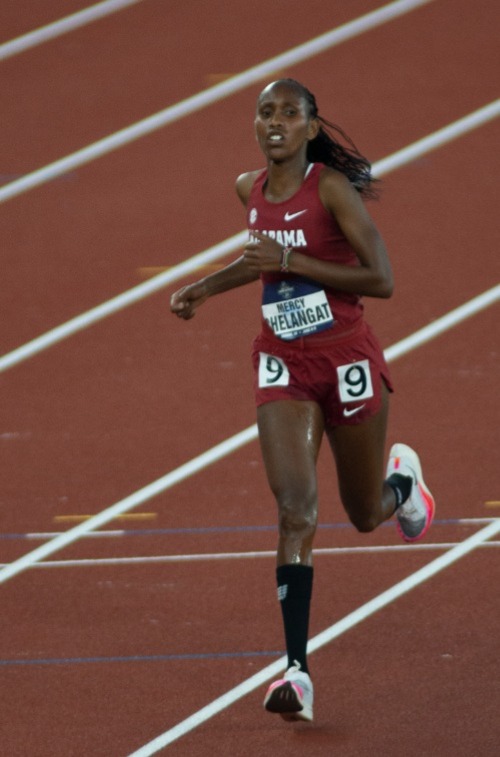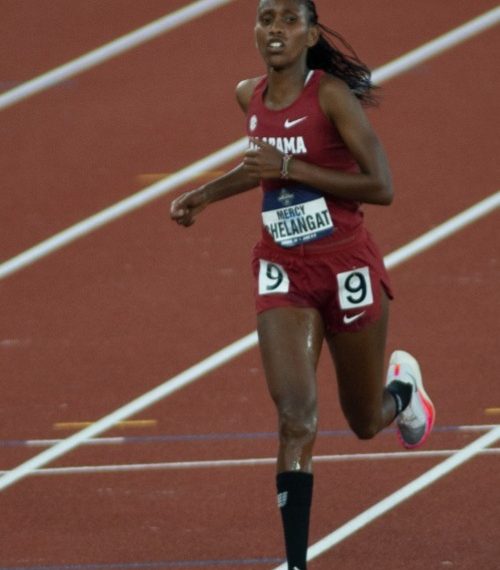Madeline Ryan wrote this piece on the women’s 10,000m. I liked her approach. She told us the stories not only of the winner but of second place, and the challenges both endured to take their places on the podium. It gives you, our reader, another view of the amazing sport we love. Special thanks to Professor Lori Schontz and her SOJC team from the University of Oregon.

RelatedPosts
Mercy Chelangat, and 6.22 miles to go before she sleeps…2022 NCAA Champs, W 10,000m, photo by Kevin Neri
By Madeline Ryan
SOJC Track Bureau
The lights turned on in Hayward Field close to the halfway point of the women’s 10,000-meter final Thursday on the second day of the NCAA Championships. On the track, Washington junior Haley Herberg was struggling to keep the drastic lead she built from the beginning of the race. At some points, the lead brought her almost 25 seconds ahead of Rice University’s Grace Forbes, who led the chase pack.
But as the skies darkened, Herberg’s lead was evaporating. It wouldn’t keep her at the front when she lost energy, and the pack of six women behind her began to push the pace.
“It’s mixed because I’m thinking, well, if they’re going to pass me, they’re going to have to make up a lot of space,” Herberg said. “But it’s also kind of scary.”
She didn’t keep the position.
After 18 laps in the first place, Herberg couldn’t maintain her lead or consistent pace when Mercy Chelangat, a junior from Alabama and the 2021 NCAA runner-up, stopped being patient and kicked past her. Forbes passed Herberg too, spreading away from her position as the chase pack leader.
The race transformed into a challenge between Forbes and Chelangat, but it wasn’t close for long. Chelangat ran at the front for the final laps and was 50 meters ahead of Forbes with two laps to go. Forbes couldn’t respond to Chelangat’s kick.
“I wasn’t really surprised,” Chelangat said. “Because I know my strength.”
Chelangat won in a season-best of 32 minutes, 37.08 seconds. Forbes also achieved a season-best in 32:48.07.
For Forbes, a second-place finish at the championships meant more. She was diagnosed with Hashimoto’s thyroiditis this year, an autoimmune disease. Forbes said she has four cysts on her thyroid and suffered from extreme exhaustion over the summer. On top of her recovery, she is also preparing to take the MCAT in August and has been studying eight hours a day.
“You know, it almost brings me to tears,” Forbes said about finishing runner-up. “I had probably the hardest semester of my life.”
Forbes said her Hashimoto’s thyroiditis was triggered by getting the COVID-19 booster shot. Her family has a long history of autoimmune disorders, so she said she expected her own autoimmune disorder to develop eventually. But she worked to adapt to her situation and recover.
“I went from running 10 miles a week to 70 miles in training. I didn’t give up,” she said. “And now I’m here.”
Forbes improved from seventh place in the 10,000 meters at NCAAs last year. She led the chase pack for most of the race in 2021, and so this year’s race was a repeat of history. She said she wasn’t comfortable in that position.
“This year’s goal was not to lead the chase pack,” she said. “I tried to make a move and make someone else go, and she took the lead and then gave it back to me. So I said, ‘OK. Time to go.'”
The win only further cemented Chelangat’s domination over the 10,000. She is the 2021 and 2022 SEC champion in the 5,000 meters and the 10,000 meters. She will be competing for the distance double at NCAAs, running the 5,000-meter final on Saturday night.
She said she’s a little worried about Saturday night because other runners will be more rested than she is. But she was proud to bring home a title for Alabama.
“It’s amazing. I’ve been wanting to do this for some time now,” she said. “I’m really happy with what I’ve done today.”























